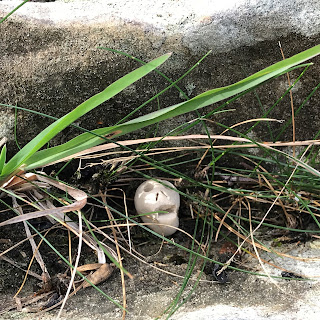On an unseasonably sunny day I went for a stroll along the River Almond. The Almond runs from Hirst Hill in Lanarkshire to its exit into the Firth of Forth at Cramond. The river is twenty-eight miles long and winds its way through West Lothian and round the outskirts of Edinburgh. The name of the river comes from the old Celtic word Amon, which means river. So, the name of the river is basically River River.
I
joined the Almond at its exit into the sea at Cramond and walked along the
riverbank up the path to the Old Cramond Brig (bridge). On crossing that, I cut off down the path
under the new bridge that carries the traffic speeding along the A90. The noise from the traffic is a continuous
thunderous rumble and as I walked through the nearby woods, I could just make
out some birdsong, which made me wonder how the birds can possibly communicate
above all that noise. Maybe they just
sing a bit louder.
Once
under and past the new bridge the river path winds on for miles and miles. One day I will walk, or cycle, as far as the
path carries me, but not today.
Today
I walked to the SEPA Monitoring Site on the Almond at Craighall. SEPA, the Scottish Environment Protection
Agency, has 392 sites around Scotland that monitor water levels. The information from these sites helps in
flood management, amongst other things.
The
monitoring site at Craighall is a rather unimpressive, purely functional, brick
building. Its walls are cracked and
pitted with holes and it is heavily graffitied on the wall facing the path. At its side there is a set of rather worn
steps and what looks like a lovely, shiny ruler. This ruler is the basic, but effective tool
for measuring the level of the river. At
the time of my trip out there the level was just under 50 centimetres. According to the River Levels UK website the
usual range of the level of the Almond is between 0.21 and 1.92 metres, though
it reached 3.76 metres in April 2000…a particularly wet year I have no
recollection of. I must have spent most
of it in the pub, to keep out of the rain.
I
left the Skulferatu that accompanied me on today’s walk in one of the many
little holes in the wall of the monitoring station, facing out onto the River
Almond.
The
coordinates for the location of the Skulferatu are –
Latitude 55.962894
Longitude
-3.338132


















